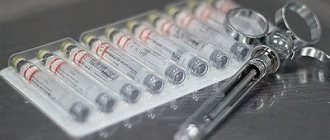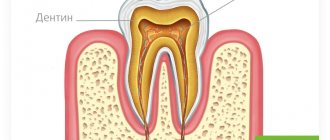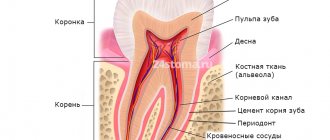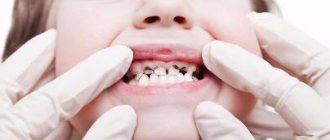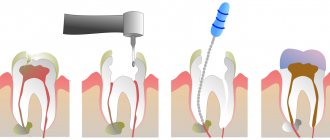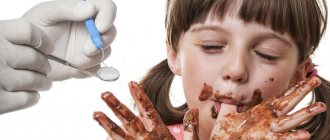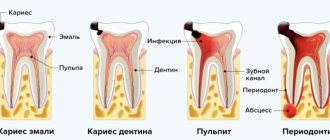- Questions and answers
- Stock
- Reviews
| Prices | Is it important to treat childhood caries? | Symptoms | Stages of caries | Treatment methods |
Caries of primary and permanent teeth occurs in 70-80% of children. This is due to the fact that children do not take good care of their oral hygiene and are partial to sweets. Do I need to treat the first teeth that will have to be removed anyway? What treatment methods are used in dentistry? How much does it cost to treat caries in children at the NovaDent clinic?
Prices
| Baby teeth | Price |
| Treatment of milk caries with placement of a filling made of glass ionomer cement | 2 350 ₽ |
| Treatment of caries with light polymerization fillings | 3 500 ₽ |
| Treatment of initial and superficial caries with Icon | 3 500 ₽ |
| Baby teeth | Price |
| Treatment of caries with filling made of glass ionomer cement | 2 350 ₽ |
| Treatment of caries with light polymerization fillings | 3 500 ₽ |
| Treatment of initial and superficial caries with Icon | 3 500 ₽ |
| Permanent teeth | Price |
| Temporary filling | 300 ₽ |
| Medical pad | 550 ₽ |
| Treatment of caries with placement of a light polymerization filling (anesthesia, cavity formation, antiseptic treatment, filling) | 2500 – 4 500₽ |
| Tooth restoration | 5 500 ₽ |
| Permanent teeth | Price |
| Temporary filling | 300 ₽ |
| Medical pad | 550 ₽ |
| Treatment of caries with placement of a light polymerization filling (anesthesia, cavity formation, antiseptic treatment, filling) | 2500 – 4 500 ₽ |
| Tooth restoration | 5 500 ₽ |
You can make an appointment with a pediatric therapist by multi-line phone or online on the website.
In our center, pediatric dentistry operates in the following clinics:
- Bratislavskaya, VDNKh, Verkhniye Likhobory, Krasnogorsk, Oktyabrskoye Pole, Petrovsko-Razumovskaya, Skhodnenskaya
Why is it necessary to treat childhood caries promptly?
- Deep dental caries in children can provoke dangerous complications, pulpitis and periodontitis, acute pain and loss of a dental unit. And due to the fact that young children are not able to tolerate pain, treatment of the disease in an advanced stage must be carried out under general anesthesia or sedation.
- The rudiments of permanent units are located under the milk ones. Serious infections and early removal of primary teeth can lead to dental problems in adulthood.
- Dairy milk is more porous in its structure, so caries in children progresses faster. If treatment is not started on time, after 3-6 months a small carious spot can lead to deep caries and pulpitis.
To detect the disease at an early stage, visit the pediatric dentist once every 3-4 months.
Why can a child get pulpitis?
- Pulpitis in a child can begin as a complication of untreated caries. The main danger is that the disease is often asymptomatic, and parents miss its onset. Only regular preventive examinations by a pediatric dentist can help dramatically.
- Infection can enter the pulp with blood after an acute infectious disease. In this case, against the background of a decrease in general immunity, the child develops pulpitis without carious lesions of the tooth.
- Injury to a baby tooth can also cause infection - this often happens to restless teeth. You should not miss a tooth bruise and be sure to immediately seek help from a pediatric dentist who can prevent the disease.
- Mistakes by a dentist when treating caries - treating the oral cavity with aggressive antiseptic solutions, such as alcohol, overheating of tooth tissue during preparation without good cooling, or incorrectly selected filling material can provoke pulpitis.
Symptoms of the disease
A child cannot always point out the source of pain and discomfort, so parents need to be especially attentive to their child’s behavior and monitor the condition of the oral cavity. The following symptoms should alert you:
- Refusal to eat, tearfulness while eating;
- Chewing food on only one side of the jaw;
- Painful sensations from hot, cold and sweet;
- Yellow or white spots, dark streaks on tooth enamel;
- Bad breath.
If you observe one or more of the signs listed above in your child, contact your dentist immediately.
Stages of caries
There are 4 stages of caries in primary teeth.
Elementary
– the stage of a carious stain is characterized by softening and demineralization of the enamel. The tooth surface loses its uniformity and becomes rough with white or light brown inclusions. At this stage, caries is asymptomatic.
Surface
– the destruction of the outer shell of the tooth continues, the shade of the enamel deteriorates, the nerve begins to react to temperature stimuli, sweet foods and drinks.
Average
– bacteria penetrate into the inner layers of the tooth, and the upper layers of dentin begin to deteriorate. At this stage, the carious cavity is clearly visible. Sensitivity to hot, cold and sweets increases.
Deep
– the infection spreads and affects an increasing proportion of dentin. At this stage of the disease, the risk of complications increases, including tooth loss.
Diagnostic features
To identify pathologies, the doctor uses several examination methods:
- Visual inspection. Allows you to assess the degree of enamel damage. More effective after cleaning from plaque or tartar.
- Probing. The depth and boundaries of the carious cavity are determined using a dental probe. This tool also allows you to determine the nature and intensity of pain.
- Coloring. The dye penetrates better into the affected porous tissue, defining the boundaries of the carious area on the enamel.
- X-ray. They are done to identify pathology in deep tissues: the root part, periodontium, soft tissues. In the picture you can see damage to the pulp, granulomas, cysts.
For a more detailed study, a computed tomography is performed, which makes it possible to detect even a latent form of the disease, as well as other disorders in the dental system.
Features of caries treatment in children
The dentist must treat small patients with care and choose the most gentle and painless treatment possible. In dental therapy for children, the doctor follows the following rules:
- The duration of the appointment is no more than 30 minutes
. - , application anesthesia
is mainly used , less often - infiltration anesthesia (injection). For pain relief, the same drugs are used as for adults, only in smaller doses. - Treatment of caries in young children is carried out without drilling
using gentle methods: fluoridation and the infiltration method (with the drug Icon). - To remove deep caries in children under 3 years of age, filling with glass ionomer cement or photopolymer composite is used, usually under general anesthesia or sedation.
Treatment methods for caries of primary teeth
Initial and superficial caries of baby teeth can be treated without a drill. In young children, carious stains on tooth enamel are effectively removed by infiltration using the unique German Icon technology. Fluoridation is also widely used.
Treatment without drilling with Icon
The technique consists of applying a special paste to a previously dried surface, which restores the enamel and stops the development of caries. Icon is completely painless and does not require anesthesia.
Indications:
usually carried out 6 months after the complete eruption of a particular tooth, suitable for children over 2 years old.
Fluoridation
Treatment of the tooth surface with fluoride-containing pastes with calcium, which restore enamel. Remineralization is an effective, painless and absolutely safe procedure. Thanks to fluoridation of children's teeth, the enamel layer becomes denser and less vulnerable to the negative effects of bacteria and acids, which cause dental caries.
Indications:
used from an age when the child is able not to swallow the medicinal solution.
Fissure sealing
The essence of the method is filling grooves and tubercles on the tooth surface with special fluorine-containing materials. The technique protects against the penetration of pathogenic bacteria into the tooth and reduces the likelihood of caries by 90%. Fissure sealing is carried out in two ways: invasive and non-invasive.
Indications:
It is advisable to carry out no later than 2.5-3 years.
Important:
All treatment procedures are carried out only after professional cleaning of baby teeth.
Read more about the treatment of baby teeth.
The Forbidden fruit is sweet…
In order not to tempt your baby with “forbidden fruits,” simply do not buy them or consume them yourself. There is no doubt that your friends and relatives all bring sweets to the child solely with the best intentions. Try to talk to them and explain that instead of candy, you can bring your child, for example, a toy or an interesting book. Due to poor or complete lack of oral hygiene, the plaque that remains on the teeth after eating food turns into dental plaque containing bacteria that produce lactic acid, which damages the enamel and contributes to the development of caries. As soon as a child has his first teeth, he should immediately have age-appropriate toothpaste and a brush. Developing the habit of brushing your teeth at an early age twice a day (in the morning and also in the evening, after meals) will prevent many problems.
Treatment of caries of permanent teeth in children
At the initial stage, caries of permanent teeth can also be cured without drilling or preparation. The same methods are used as in the treatment of primary teeth. Sealing the fissures of molar teeth is recommended as the most effective prevention of caries.
Filling is the main method of treating permanent teeth in children. Filling technology for children is practically no different from therapy for adults. For restoration in this case, photopolymer composites of the latest generation are more often used.
The permanent tooth is filled according to the following scheme:
- Preparation, cleaning of carious cavity;
- Treatment with an antiseptic drug;
- Restoration with photopolymer composite;
- Polishing and grinding of the filling.
Tooth restoration is carried out under local anesthesia. Doses are selected individually depending on the age of the child.
How can children live without sweets and what can they replace them with?
- The best sweets are fruits and DRIED FRUITS. Fruits and their dried counterparts contain natural sugars that are not digested by carious bacteria. Hard fruits (an apple, for example) clean teeth well, especially when it is not possible to brush your teeth. True, no apple can replace traditional teeth brushing;
- Dairy products are a source of easily digestible calcium for your child’s teeth.
- Honey is a good natural sweetener, useful not only for teeth. Its healing properties have been known for many centuries. The sugars contained in it are not digested by carious bacteria. In addition, honey has mild antiseptic and wound-healing properties.
Special offer
Participate in the promotion
Promotion “1+1”: child and parent
You have entrusted NovaDent with the treatment of your child’s teeth, as a token of gratitude we are giving you a free consultation with any specialist (surgeon, implantologist, therapist, orthodontist, hygienist), as well as an orthopantomogram (panoramic photograph of the teeth) sent by email.
Take time for your health and take advantage of this great offer! Participate in the promotion
Expert of the article you are reading: Lapshina Maria Aleksandrovna Dentist, pediatrician
21 years
Clinical experience
Krasnogorsk
Moscow region, Krasnogorsk, Podmoskovny Boulevard, 5
+7
Free consultation with this specialist


